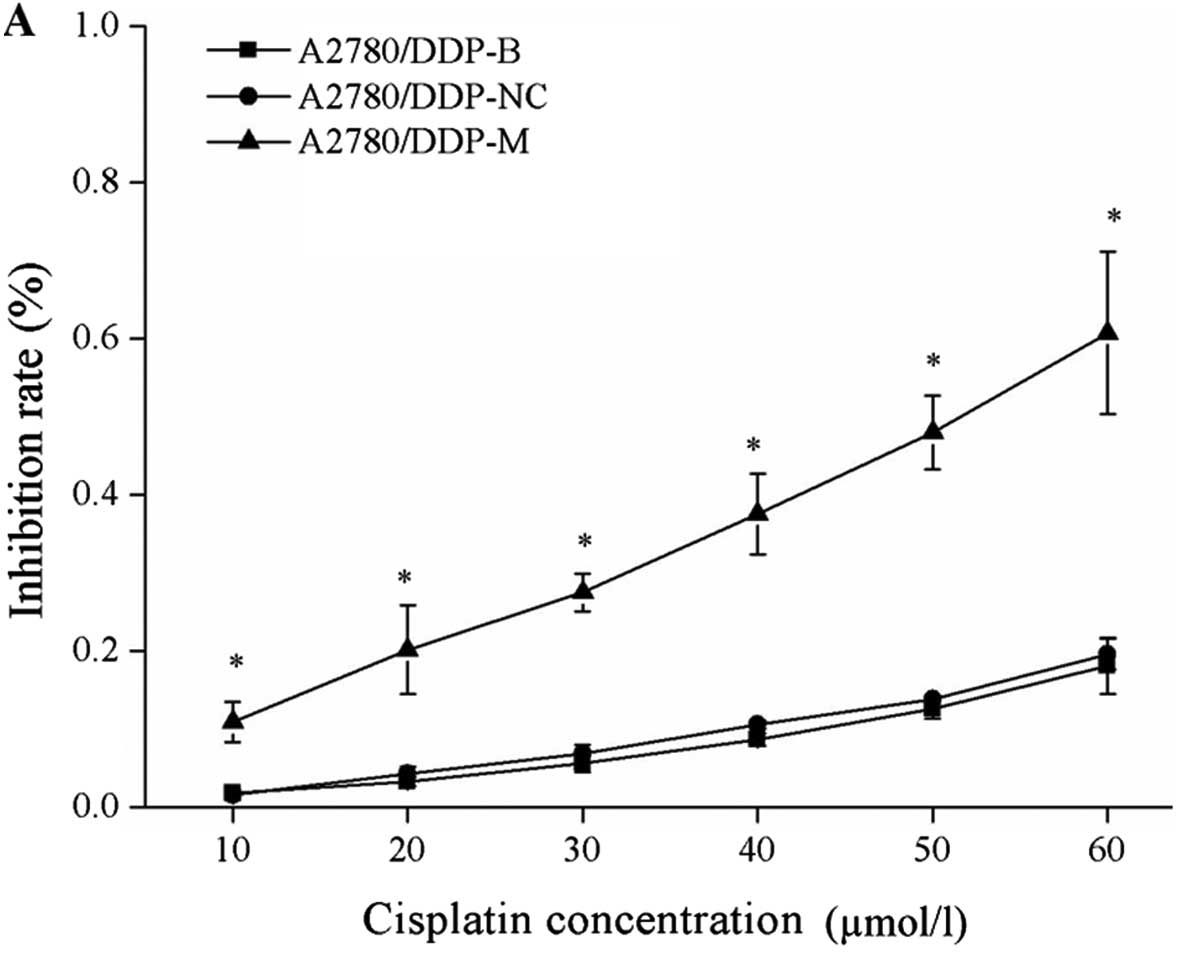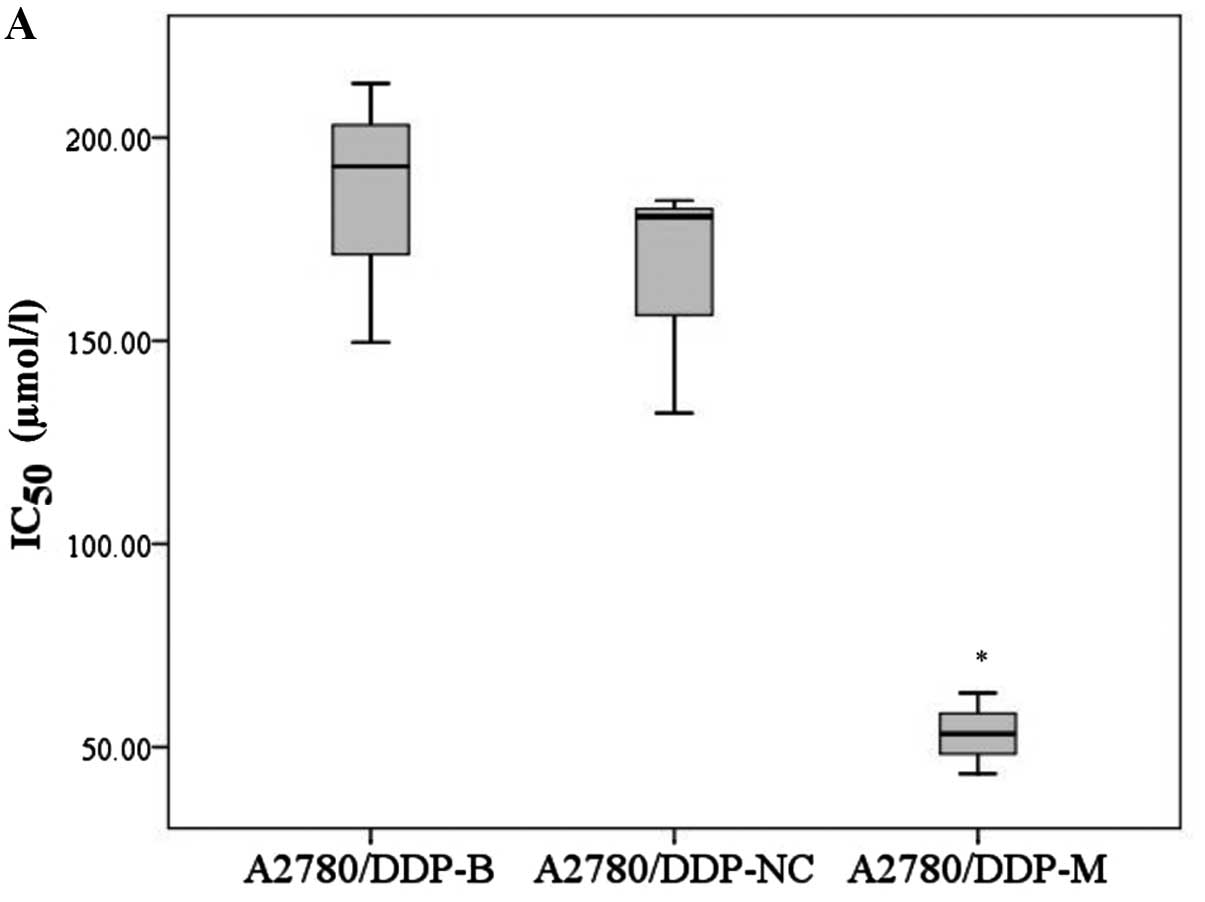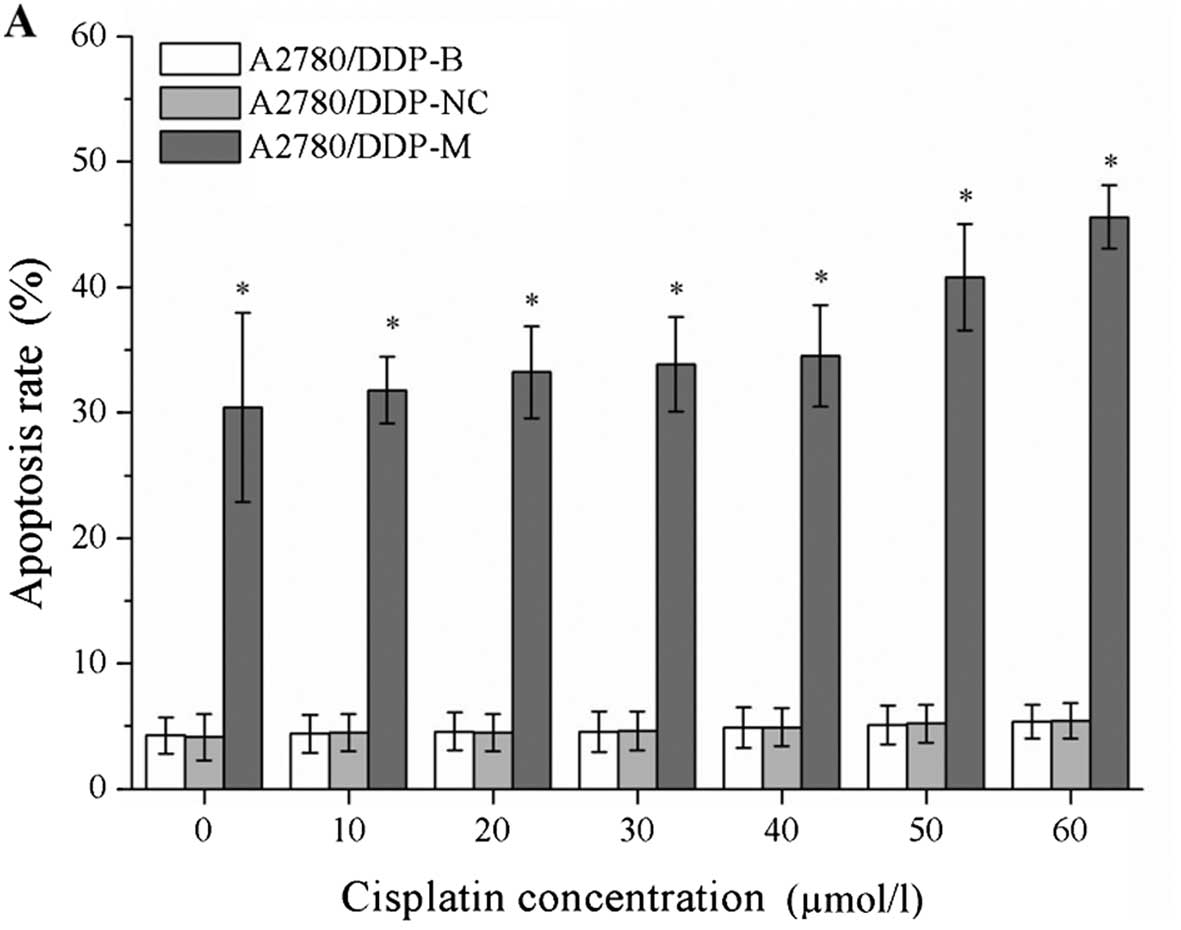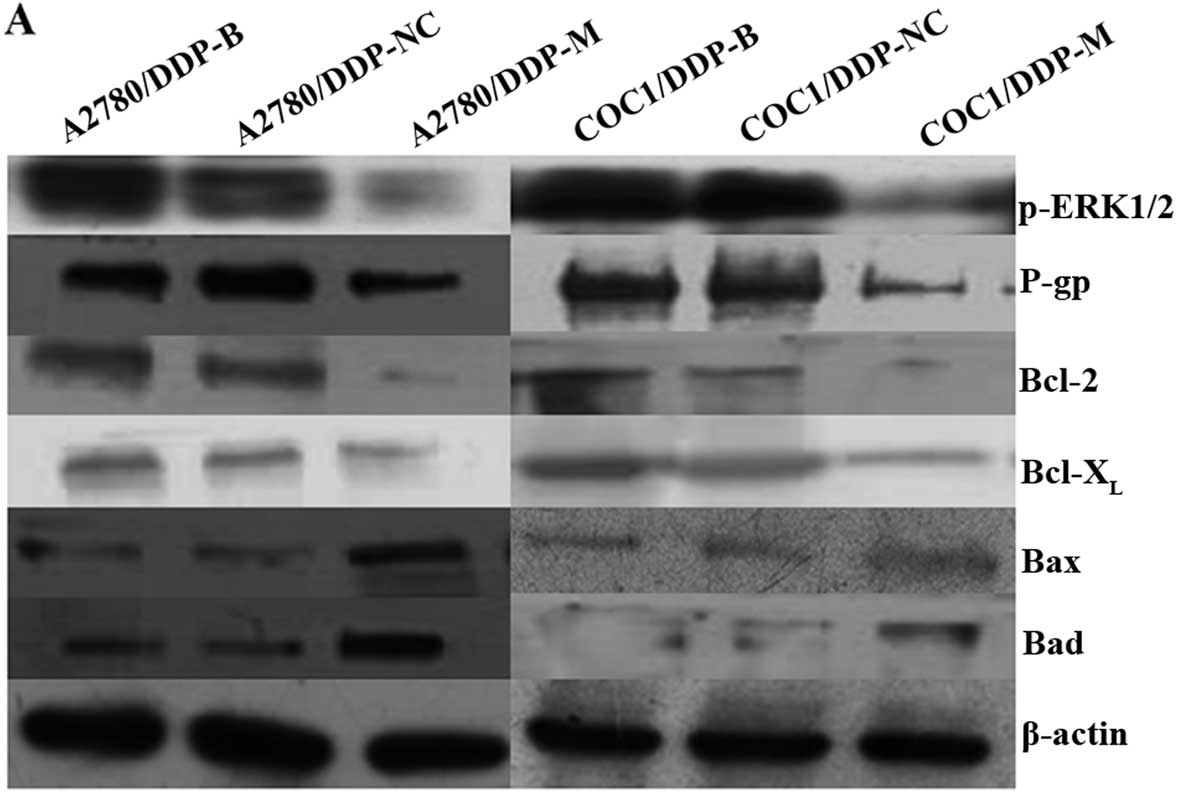Knockdown of MACC1 expression increases cisplatin sensitivity in cisplatin-resistant epithelial ovarian cancer cells
- Authors:
- Published online on: January 21, 2016 https://doi.org/10.3892/or.2016.4585
- Pages: 2466-2472
Abstract
Introduction
Epithelial ovarian cancer (EOC) is commonly detected at a late stage, and is commonly diagnosed with abdominal ascites and widespread intraperitoneal dissemination. Aggressive cytoreductive surgery, if possible, is the primary clinical treatment for advanced ovarian cancer (1,2). Platinum and paclitaxel combination chemotherapy or i.p. cisplatin based-chemotherapy is used as a first-line neoadjuvant before cytoreductive surgery or adjuvant treatment after surgery (3,4). Most patients develop platinum chemoresistance or multi-drug resistance during the chemotherapy progress, which is a major obstacle for chemotherapy in ovarian cancer patients (5). Therefore, the identification of platinum-resistance mechanisms and the exploration of chemoresistance reversing therapeutic targets for human EOC are required.
MACC1 was found to be overexpressed in colon cancer, gastric carcinoma, lung cancer, hepatocellular carcinoma and ovarian cancer, and may be used as a biomarker for the poor prognosis and the high risk of metastasis in these malignant tumors (6–10). It was found that downregulation of MACC1 by siRNA sensitized pancreatic cancer cells to gemcitabine treatment, which may be involved in the inhibition of the Ras/ERK signaling pathway (11). Another study showed that knockdown of MACC1 enhanced the apoptosis and growth inhibitory rates of human glioblastoma cells, and could increase glioblastoma cell sensitivity to cisplatin chemotherapy (12). These data indicated that, in addition to invasion and metastasis, MACC1 may also play other unknown roles in the pathological processes of cancer cells, such as chemoresistance.
Herein, we hypothesized that MACC1 may be implicated in the chemoresistance of cisplatin in ovarian cancer. To verify this hypothesis, we inhibited the expression of MACC1 in cisplatin-resistant ovarian cancer A2780/DDP and COC1/DDP cells by RNA interference. Chemosensitivity and the apoptosis rate in different ovarian cancer cells were determined following treatment with different concentrations of cisplatin. Expression levels of apoptosis-associated proteins and caspase-3 activity were assessed. The relationship between MACC1 and cisplatin resistance was investigated.
Materials and methods
Cell transfection
Human ovarian carcinoma A2780/DDP and COC1/DDP cells were purchased from the China Center for Type Culture Collection (Wuhan, China), and cultured in complete RPMI-1640 medium (Hyclone, Logan, UT, USA), at 37°C in 5% CO2. Cells were harvested in the logarithmic phase of growth for all experiments as described below. Recombinant MACC1-psuper-EGFP-shRNA eukaryotic plasmids and the negative control plasmid, as constructed in our previous study (13), were transfected into the A2780/DDP and COC1/DDP cells, respectively, which was performed following the protocol of Lipofectamine 2000 reagent (Invitrogen, Carlsbad, CA, USA). Stably transfected A2780/DDP and COC1/DDP cells were isolated by G418 (Sigma, St. Louis, MO, USA). Three cell groups used for the next research steps were named: blank control cells (B), negative control cells (NC) and MACC1-knockdown cells (M).
sqRT-PCR
Cell total RNA was isolated using TRIzol reagent (Invitrogen), and first strand cDNA was synthesized from 1 µg total RNA according to the protocol of the RevertAid First Strand cDNA Synthesis kit (Fermentas, EU). Primers used in the sqRT-PCR were MACC1, 5′-CCTTCGTGGTAATAATGC TTCC-3′ (sense) and 5′-AGGGCTTCCATTGTATTGAGGT-3′ (antisense); and β-actin, 5′-ACGCACCCCAACTACAACTC-3′ (sense) and 5′-TCTCCTTAATGTCACGCACGA-3′ (antisense). PCR cycling parameters (19 cycles) were: denaturation (94°C for 30 sec), annealing (56°C for 30 sec) and extension (72°C for 30 sec). Equal amounts of PCR products were electrophoresed on 1.2% agarose gels and visualized by ethidium bromide staining. The specific bands of the PCR products were analyzed by Image-Pro Plus 6.0 system, and β-actin was used as a control for normalization. sqRT-PCR was performed three times independently.
Western blot analysis
The antibodies used in the western blotting, following the manufacturer's protocols, included rabbit anti-human polyclonal MACC1 (Sigma), rabbit anti-human polyclonal phospho-ERK1/2 and mouse anti-human monoclonal P-gp (Santa Cruz Biotechnology, Santa Cruz, CA, USA), rabbit anti-human polyclonal Bcl-2, rabbit anti-human monoclonal Bcl-XL, mouse anti-human monoclonal Bax, and rabbit anti-human polyclonal Bad (Beyotime Biotechnology, Haimen, Jiangsu, China). Total protein was extracted using RIPA lysis buffer for western blot analysis and IP (Beyotime Biotechnology), and the protein concentration was determined using Bradford assay. Equal amounts of protein (30 µg) were separated by 10% SDS-PAGE and transferred onto PVDF membranes. The detection of hybridized protein was performed by enhanced chemiluminescence kit (Zhongshan Goldenbridge Biotechnology, Peking, China), and β-actin was used as a control for normalization. The relative values of the specific bands were analyzed by Image-Pro Plus 6.0 system three times independently.
MTT assay
Cells were planted (1×104 cells/well) into 96-well plates, and 100 µl complete RPMI-1640 medium containing 10% FBS was added into each well. Three duplicate wells were set up for each group. The cells were cultured for 24 h, and then medium containing cisplatin at 0, 10, 20, 30, 40, 50, and 60 µmol/l, respectively was added. The cells were incubated for 48 h, and the previous medium was replaced by 100 µl complete RPMI-1640 medium in each well. After 24 h, 20 µl MTT reagent (5 mg/ml; Sigma) was added into each well. Cells were then incubated for another 4 h and then the former medium was aspirated and 150 µl DMSO was added. The absorbance of the sample was measured by a microplate spectrophotometer (Thermo Spectronic, Madison, WI, USA) at 492 nm. All experiments were conducted in triplicate. Cell growth inhibition rate and the half inhibitory concentration (IC50) value of cisplatin (LOGIT assay) were calculated. Cell growth inhibition rate = (1 − sample OD/control OD) × 100%.
Flow cytometric analysis
Every cell group was captured for 48 h in medium containing cisplatin at 0, 10, 20, 30, 40, 50 and 60 µmol/l, respectively. The cells were incubated for another 24 h with complete RPMI-1640 medium. Approximately 1×106 cells were treated into a single-cell suspension with PBS solution, and were prepared following the manufacturer's protocol in the Annexin V-FITC Apoptosis Detection kit (Beyotime Biotechnology). Then, rates of apoptosis were analyzed with FACScan system (BD Biosciences, San Jose, CA, USA).
Caspase-3 activity assay
Every cell group was cultured for 48 h in medium containing cisplatin at 0, 10, 20, 30, 40, 50 and 60 µmol/l, respectively, and then incubated for another 24 h with completed RPMI-1640 medium. Approximately 1×106 cells were collected, total protein was extracted using RIPA lysis buffer for western blot analysis and IP (Beyotime Biotechnology), and the protein concentration was controlled using Bradford assay (between 1 to 3 mg/ml as requested). Equal volumes of protein (50 µl) were prepared following the manufacturer's protocol in the Caspase-3 Activity Detection kit (Beyotime Biotechnology). The absorbance values were measured by a microplate spectrophotometer (Thermo Spectronic) at 405 nm. The pyrolysis liquid without the cell samples was used as a blank control. The value of ΔA405 (absorbance value of sample at 405 nm minus absorbance value of blank control at 405 nm) represents the activity of caspase-3. All experiments were performed in triplicate.
Statistical analysis
Average values are expressed as mean ± standard deviation (SD). Measurement data were analyzed by one-way ANOVA, non-parametric test and Bonferroni test using SPSS 17.0 software package. A difference was considered significant at P<0.05.
Results
MACC1 mRNA and protein expression is altered after RNA interference
As a result of MACC1 knockdown, significant downregulation of MACC1 was observed in the A2780/DDP-M and COC1/DDP-M cells (P<0.05). No differences were noted between the A2780/DDP-B and A2780/DDP-NC cells, and between the COC1/DDP-B and COC1/DDP-NC cells (Fig. 1).
Suppression of cell proliferation after MACC1 knockdown
After incubation with different concentrations of cisplatin, cell growth inhibition rates were obviously increased in the A2780/DDP-M and COC1/DDP-M cells (χ2=9.029, P=0.011; χ2=6.226, P=0.044). With higher concentrations of cisplatin, increased rates of cell growth inhibition were noted (P<0.05). No differences were found between the A2780/DDP-B and A2780/DDP-NC cells, between the COC1/DDP-B and COC1/DDP-NC cells (Fig. 2).
In addition, the IC50 values of A2780/DDP-M and COC1/DDP-M cells for cisplatin were obviously decreased compared with the control cells (F=22.760, P=0.002; χ2=6.489, P=0.039). No differences were noted between the A2780/DDP-B and A2780/DDP-NC cells, and between the COC1/DDP-B and COC1/DDP-NC cells (Fig. 3).
Cell apoptosis is induced by RNA interference
After incubation with different concentrations of cisplatin, the cell apoptosis rates were markedly increased in the A2780/DDP-M and COC1/DDP-M cells (χ2=41.375, P=0.000; χ2=41.362, P=0.000). For a higher concentration of cisplatin, greater rates of cell apoptosis were observed (P<0.05). No differences were noted between the A2780/DDP-B and A2780/DDP-NC cells, and between the COC1/DDP-B and COC1/DDP-NC cells (Fig. 4).
Expression of p-ERK1/2, P-gp, Bcl-2, Bcl-XL, Bax and Bad in the different cell groups
After MACC1 knockdown, obvious downregulation of p-ERK1/2, P-gp, Bcl-2 and Bcl-XL was detected in the A2780/DDP-M and COC1/DDP-M cells (P<0.05). In contrast, upregulation of Bax and Bad was found in the A2780/DDP-M and COC1/DDP-M cells (P<0.05). No differences in these proteins were noted between the A2780/DDP-B and A2780/DDP-NC cells, and between the COC1/DDP-B and COC1/DDP-NC cells (Fig. 5).
Caspase-3 activity is increased by RNA interference
After incubation with different concentrations of cisplatin, the values of ΔA405 were markedly increased in the A2780/DDP-M and COC1/DDP-M cells (χ2=41.345, P=0.000; χ2=41.349, P=0.000). At a higher concentration of cisplatin, a greater value for ΔA405 was observed (P<0.05). These data indicate that the activity of caspase-3 was increased in the A2780/DDP-M and COC1/DDP-M cells. No differences were noted between the A2780/DDP-B and A2780/DDP-NC cells, and between the COC1/DDP-B and COC1/DDP-NC cells (Fig. 6).
Discussion
Platinum compounds are the mainstay of chemotherapy for ovarian cancer, particularly for advanced patients. Cisplatin, a conventional chemotherapy drug, has long-term clinical application in ovarian cancer (14). Unfortunately, intrinsic or acquired platinum resistance remains a critical obstacle for chemotherapy treatment of epithelial ovarian cancer. After tumor cytoreductive surgery, only 70–80% of ovarian cancer cases are responsive to platinum combined chemotherapy (15).
MACC1 has been found to be associated with invasion and metastasis in numerous types of malignant tumors. Our previous studies showed that MACC1 mRNA and protein were overexpressed in ovarian cancer tissues and cells. Inhibition of MACC1 by RNA interference suppressed the invasion and metastatic potential of ovarian carcinoma cells in vitro and in vivo, and the antitumor effects of MACC1 knockdown may involve the inhibition of the MEK/ERK1/2 pathways (10,13).
Recently, it has been reported that small interfering RNA targeting MACC1 attenuates cisplatin resistance in tongue squamous cell carcinoma cells (16). However, another research team claimed that downregulation of MACC1 expression by RNA interference technology had no effect on cisplatin resistance in salivary adenoid cystic carcinoma cells (17). The present results showed that MACC1 was obviously downregulated in the A2780/DDP and COC1/DDP cells by RNA interference. After MACC1 knockdown, cell growth was repressed, IC50 values of cisplatin were decreased, and the cell apoptosis rate was increased in the A2780/DDP and COC1/DDP cells following treatment with different concentrations of cisplatin. These data indicate that inhibition of MACC1 improves the cisplatin sensitivity of ovarian cancer cisplatin-resistant cells, and MACC1 may be involved in the chemoresistance of cisplatin in ovarian cancer.
The MAPK-ERK1/2 pathway has been implicated in cell survival, anti-apoptosis, invasion, metastasis, angiogenesis and chemoresistance of malignancies, including ovarian carcinoma (18–21). P-glycoprotein (P-gp), also known as MDR1 or the ATP-binding cassette subfamily B member 1, is involved in the drug resistance of tumor cells. P-gp is important for transporting drugs across the cell membrane to pump drugs out of the cells and to decrease intracellular drug concentrations (22). Inhibition of MDR1 or P-gp expression can enhance drug chemosensitivity in malignant tumor cells, including ovarian cancer (23–26). Chemotherapy drugs play therapeutic roles in cancer through different mechanisms, mainly by inhibition of cell growth and induction of cell apoptosis. The Bcl-2 gene family plays key roles in cell apoptosis and cancer therapy (27). Bcl-2 and Bcl-XL are important anti-apoptotic proteins; Bax and Bad are pro-apoptotic proteins. Overexpression of Bcl-2 leads to drug-resistance to cisplatin in ovarian tumor cells, and Bcl-2 inhibition by gene silencing induces cell apoptosis and reverses drug resistance (28,29). Caspase-3 is the most important apoptotic protease cascade protein in the caspase family, which can implement programmed cell death under the regulation of Bcl-2 family proteins (30,31).
Following MACC1 knockdown, expression levels of p-ERK1/2, P-gp, Bcl-2 and Bcl-XL protein were obviously decreased, while expression levels of Bax and Bad were significantly increased in this study. Furthermore, caspase-3 activity was markedly increased in the MACC1-knockdown ovarian cancer cells. These results elucidate the possible mechanisms of MACC1 involved in the cisplatin-resistance of ovarian cancer cells. These mechanisms may include the regulation of P-gp expression through the ERK1/2 signaling pathway, which affects the expression of pro-apoptotic and anti-apoptotic proteins, and the activity of caspase-3 downstream.
In conclusion, the present study demonstrated that suppression of MACC1 improves the chemosensitivity of cisplatin in epithelial ovarian cancer cells, which may be through regulation of the ERK1/2 signaling pathway and P-gp and its downstream apoptotic proteins.
Acknowledgments
We thank the Clinical Medicine Key Disciplines Laboratory of Henan Province for assistance with the experiments. Our work was supported by the Medical Key Scientific Research Project of Henan Province (122102310545) and the Hospital Youth Fund Project of the First Affiliated Hospital of Zhengzhou University.
References
|
Ledermann JA and Kristeleit RS: Optimal treatment for relapsing ovarian cancer. Ann Oncol. 21(Suppl 7): vii218–vii222. 2010. View Article : Google Scholar : PubMed/NCBI | |
|
Schorge JO, Modesitt SC, Coleman RL, Cohn DE, Kauff ND, Duska LR and Herzog TJ: SGO White Paper on ovarian cancer: Etiology, screening and surveillance. Gynecol Oncol. 119:7–17. 2010. View Article : Google Scholar : PubMed/NCBI | |
|
Parmar MK, Ledermann JA, Colombo N, du Bois A, Delaloye JF, Kristensen GB, Wheeler S, Swart AM, Qian W, Torri V, et al ICON AGO Collaborators: Paclitaxel plus platinum-based chemotherapy versus conventional platinum-based chemotherapy in women with relapsed ovarian cancer: The ICON4/AGO-OVAR-2.2 trial. Lancet. 361:2099–2106. 2003. View Article : Google Scholar : PubMed/NCBI | |
|
Bookman MA: The addition of new drugs to standard therapy in the first-line treatment of ovarian cancer. Ann Oncol. 21(Suppl 7): vii211–vii217. 2010. View Article : Google Scholar : PubMed/NCBI | |
|
Siegel R, Naishadham D and Jemal A: Cancer statistics, 2013. CA Cancer J Clin. 63:11–30. 2013. View Article : Google Scholar : PubMed/NCBI | |
|
Shirahata A, Shinmura K, Kitamura Y, Sakuraba K, Yokomizo K, Goto T, Mizukami H, Saito M, Ishibashi K, Kigawa G, et al: MACC1 as a marker for advanced colorectal carcinoma. Anticancer Res. 30:2689–2692. 2010.PubMed/NCBI | |
|
Shirahata A, Sakata M, Kitamura Y, Sakuraba K, Yokomizo K, Goto T, Mizukami H, Saito M, Ishibashi K, Kigawa G, et al: MACC 1 as a marker for peritoneal-disseminated gastric carcinoma. Anticancer Res. 30:3441–3444. 2010.PubMed/NCBI | |
|
Shimokawa H, Uramoto H, Onitsuka T, Chundong G, Hanagiri T, Oyama T and Yasumoto K: Overexpression of MACC1 mRNA in lung adenocarcinoma is associated with postoperative recurrence. J Thorac Cardiovasc Surg. 141:895–898. 2011. View Article : Google Scholar | |
|
Shirahata A, Fan W, Sakuraba K, Yokomizo K, Goto T, Mizukami H, Saito M, Ishibashi K, Kigawa G, Nemoto H, et al: MACC 1 as a marker for vascular invasive hepatocellular carcinoma. Anticancer Res. 31:777–780. 2011.PubMed/NCBI | |
|
Zhang RT, Shi HR, Huang HL, Chen ZM, Liu HN and Yuan ZF: Expressions of MACC1, HGF, and C-met protein in epithelial ovarian cancer and their significance. Nan Fang Yi Ke Da Xue Xue Bao. 31:1551–1555. 2011.In Chinese. PubMed/NCBI | |
|
Wang G, Kang MX, Lu WJ, Chen Y, Zhang B and Wu YL: MACC1: A potential molecule associated with pancreatic cancer metastasis and chemoresistance. Oncol Lett. 4:783–791. 2012.PubMed/NCBI | |
|
Shang C, Hong Y, Guo Y, Liu YH and Xue YX: Influence of the MACC1 gene on sensitivity to chemotherapy in human U251 glioblastoma cells. Asian Pac J Cancer Prev. 16:195–199. 2015. View Article : Google Scholar : PubMed/NCBI | |
|
Zhang R, Shi H, Chen Z, Wu Q, Ren F and Huang H: Effects of metastasis-associated in colon cancer 1 inhibition by small hairpin RNA on ovarian carcinoma OVCAR-3 cells. J Exp Clin Cancer Res. 30:832011. View Article : Google Scholar : PubMed/NCBI | |
|
Chen S, Jiao JW, Sun KX, Zong ZH and Zhao Y: MicroRNA-133b targets glutathione S-transferase π expression to increase ovarian cancer cell sensitivity to chemotherapy drugs. Drug Des Devel Ther. 9:5225–5235. 2015. | |
|
Zhang Z, Xie Z, Sun G, Yang P, Li J, Yang H, Xiao S, Liu Y, Qiu H, Qin L, et al: Reversing drug resistance of cisplatin by hsp90 inhibitors in human ovarian cancer cells. Int J Clin Exp Med. 8:6687–6701. 2015.PubMed/NCBI | |
|
Li HF, Liu YQ, Shen ZJ, Gan XF, Han JJ, Liu YY, Li HG and Huang ZQ: Downregulation of MACC1 inhibits invasion, migration and proliferation, attenuates cisplatin resistance and induces apoptosis in tongue squamous cell carcinoma. Oncol Rep. 33:651–660. 2015. | |
|
Li H, Liao X, Liu Y, Shen Z, Gan X, Li H and Huang Z: The expression of MACC1 and its role in the proliferation and apoptosis of salivary adenoid cystic carcinoma. J Oral Pathol Med. 44:810–817. 2015. View Article : Google Scholar : PubMed/NCBI | |
|
Seger R and Krebs EG: The MAPK signaling cascade. FASEB J. 9:726–735. 1995.PubMed/NCBI | |
|
Nicosia SV, Bai W, Cheng JQ, Coppola D and Kruk PA: Oncogenic pathways implicated in ovarian epithelial cancer. Hematol Oncol Clin North Am. 17:927–943. 2003. View Article : Google Scholar : PubMed/NCBI | |
|
Jin W, Wu L, Liang K, Liu B, Lu Y and Fan Z: Roles of the PI-3K and MEK pathways in Ras-mediated chemoresistance in breast cancer cells. Br J Cancer. 89:185–191. 2003. View Article : Google Scholar : PubMed/NCBI | |
|
Montagut C and Settleman J: Targeting the RAF-MEK-ERK pathway in cancer therapy. Cancer Lett. 283:125–134. 2009. View Article : Google Scholar : PubMed/NCBI | |
|
Andorfer P and Rotheneder H: Regulation of the MDR1 promoter by E2F1 and EAPP. FEBS Lett. 587:1504–1509. 2013. View Article : Google Scholar : PubMed/NCBI | |
|
Chen J, Ding Z, Peng Y, Pan F, Li J, Zou L, Zhang Y and Liang H: HIF-1α inhibition reverses multidrug resistance in colon cancer cells via downregulation of MDR1/P-glycoprotein. PLoS One. 9:e988822014. View Article : Google Scholar | |
|
Wang Q, Wang Z, Chu L, Li X, Kan P, Xin X, Zhu Y and Yang P: The effects and molecular mechanisms of miR-106a in multidrug resistance reversal in human glioma U87/DDP and U251/G cell lines. PLoS One. 10:e01254732015. View Article : Google Scholar : PubMed/NCBI | |
|
Januchowski R, Wojtowicz K, Sujka-Kordowska P, Andrzejewska M and Zabel M: MDR gene expression analysis of six drug-resistant ovarian cancer cell lines. Biomed Res Int. 2013:2417632013. View Article : Google Scholar : PubMed/NCBI | |
|
Zhang T, Guan M, Jin HY and Lu Y: Reversal of multidrug resistance by small interfering double-stranded RNAs in ovarian cancer cells. Gynecol Oncol. 97:501–507. 2005. View Article : Google Scholar : PubMed/NCBI | |
|
Thomas S, Quinn BA, Das SK, Dash R, Emdad L, Dasgupta S, Wang XY, Dent P, Reed JC, Pellecchia M, et al: Targeting the Bcl-2 family for cancer therapy. Expert Opin Ther Targets. 17:61–75. 2013. View Article : Google Scholar | |
|
Babu A, Wang Q, Muralidharan R, Shanker M, Munshi A and Ramesh R: Chitosan coated polylactic acid nanoparticle-mediated combinatorial delivery of cisplatin and siRNA/Plasmid DNA chemosensitizes cisplatin-resistant human ovarian cancer cells. Mol Pharm. 11:2720–2733. 2014. View Article : Google Scholar : PubMed/NCBI | |
|
Yang HL, Lin KY, Juan YC, Kumar KJ, Way TD, Shen PC, Chen SC and Hseu YC: The anti-cancer activity of Antrodia camphorata against human ovarian carcinoma (SKOV-3) cells via modulation of HER-2/neu signaling pathway. J Ethnopharmacol. 148:254–265. 2013. View Article : Google Scholar : PubMed/NCBI | |
|
Galluzzi L, Kepp O and Kroemer G: Caspase-3 and prostaglandins signal for tumor regrowth in cancer therapy. Oncogene. 31:2805–2808. 2012. View Article : Google Scholar | |
|
Zhang SD, Shan L, Li W, Li HL and Zhang WD: Isochamaejasmin induces apoptosis in leukemia cells through inhibiting Bcl-2 family proteins. Chin J Nat Med. 13:660–666. 2015.PubMed/NCBI |















